'The knowledge of bees is the basis of the beekeeper’s success; and for all other people who, amidst the whirl of present-day technology,
still prove to have a clear feeling for lively Nature, they are a source of joyful edification.’
The Dancing Bees, Karl Von Frisch, 1967
Our Wild Honey: Absolute Purity
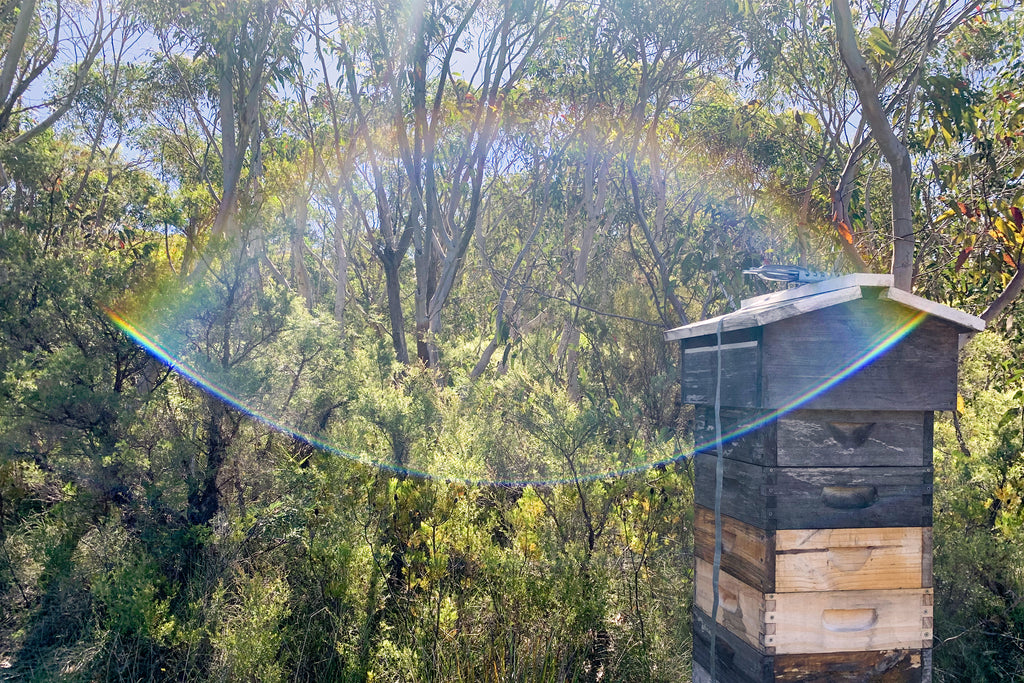 |
| Dappled rainbow light on one of our natural comb Warré hives in the Blue Mountains World Heritage wilderness |
Environmental health = Bee health = Human health
In this, our fourth article on test results, I look at how our Blue Mountains Wild honey performed in Glyphosate and Pesticide Suite tests.Chemical contamination of the environment, as well as the migration of harmful chemicals into our food system, has been a growing concern for decades. Bee colonies may be exposed to chemicals in numerous ways, affecting bee health and honey purity.
As we have always made a conscious effort to not only produce a pure food for human consumption, but more importantly, to limit the bees exposure to chemicals in the environment, we were keen to have our honey tested.
Chemical use has increased dramatically over the last century (and almost doubled since the 1990’s1) due to the rise of modern industrial agriculture and the wide availability of chemicals. Similar to other issues such as the proliferation of micro plastics2, the immense scale of contamination from chemicals such as Glyphosate and Neonicotinoids is only beginning to dawn on us. As bees are critical to both biodiversity and food security, the burden of escalating chemical use on bee colonies and other pollinators is seriously worrying and needs to be urgently addressed.
Individual bees are fuzzy creatures, elegantly designed to collect desirable ingredients - nectar, pollen, resin and water - from the environment to fuel colony health and development. Due to their unique ability to forage over vast areas, colonies literally bring the surrounding environment into the nest, and therefore, they are often used by scientists to study environmental contamination and determine how chemicals and pollutants are being recycled into food and ecological systems.
However, the routine testing of chemical residues in the honey we consume is a fairly recent phenomenon; a scientific study from just a few years ago explains that 'Glyphosate has traditionally been considered to be nearly non-toxic to humans, and therefore not problematic if ingested in food sources; as a consequence, measurement of its presence in food is very scarce'. The same study found glyphosate in 45.5% of honey samples that were labeled as Organic.3
Shockingly there is no regular monitoring of agricultural chemicals in most food sold domestically in Australia, despite a recent pilot program to monitor pesticides revealing residues up to 90 times the permitted maximum levels in strawberries4. Likewise, a recent study of 200 samples of honey sourced from around the globe found three quarters were contaminated with Neonicitinoids (a class of highly potent neurotoxins) and many contained a ‘cocktail’ of chemicals.5 Similarly, a large study in the US published in 2010 found 121 different pesticides and metabolites within 887 wax, pollen, bee and associated hive samples.6
If humans continue to poison bee colonies via beekeeper applied pest and disease treatments and also poison their food and water sources, their health will be severely compromised. Therefore, it is safe to draw the conclusion that modern conventional industrial beekeeping and agriculture practises dovetail to create a situation that harms the environment and bee health, with potentially grave implications for human health.
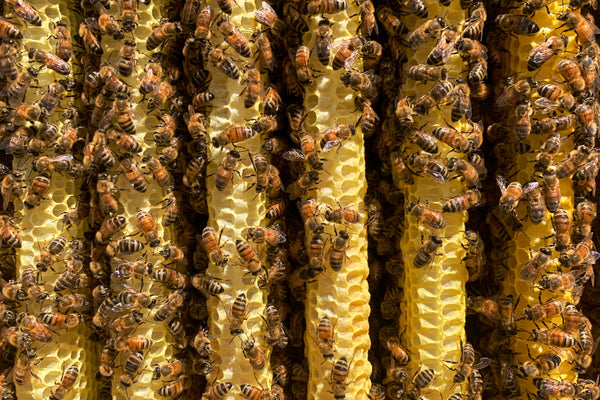 |
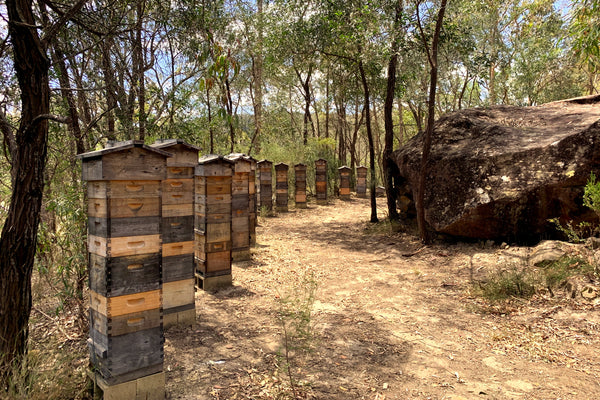 |
| Bee colonies are allowed to build 100% natural comb in our hives, guaranteeing purity | Large Warré apiary in the lower Blue Mountains, bordering the Wollemi Wilderness |
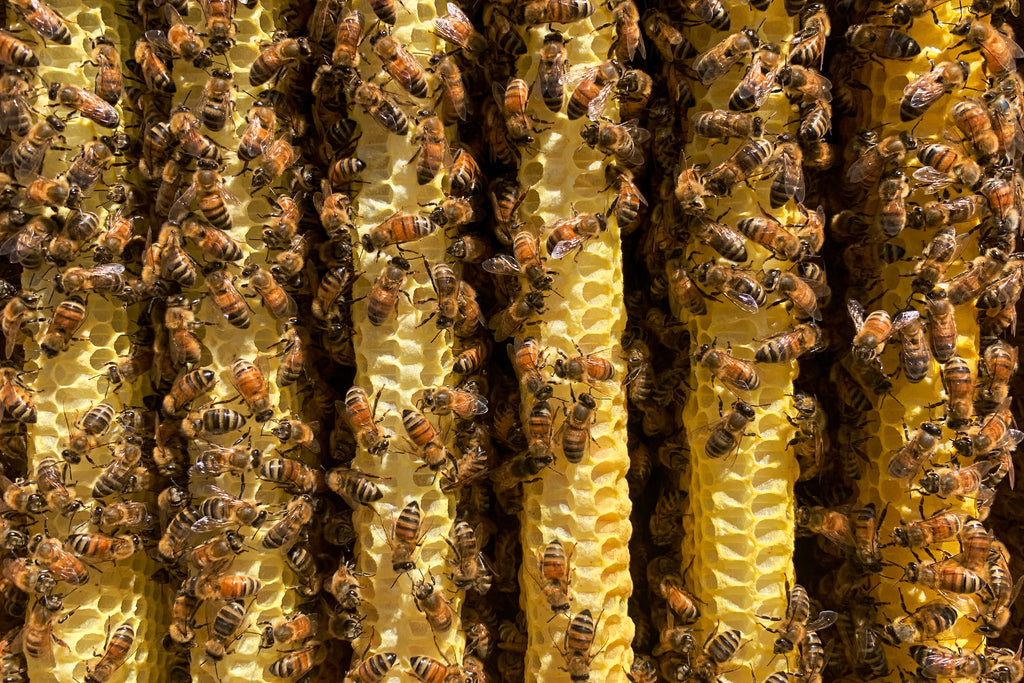 |
| Bee colonies are allowed to build 100% natural comb in our hives, guaranteeing purity |
 |
| Large Warré apiary in the lower Blue Mountains, bordering the Wollemi Wilderness |
Growing concerns about Glyphosate
Glyphosate is the buzz word when it comes to chemical contamination, and as the most widely used herbicide its omnipresence is certainly a major concern; understanding the scope of glyphosate contamination in our food supply is critical to protecting public health, as more scientific evidence continues to link glyphosate with cancer in humans. We have fielded a number of enquiries recently about whether our honey is glyphosate free and a quick search online revealed the reason for the spike in customer concern; Japan has just introduced new, stringent testing controls for Glyphosate residue in honey imported into the country. A number of shipments of New Zealand Manuka honey were found to exceed the new limits and were destroyed before entering the country, with the news going viral amongst honey lovers.7 Glyphosate Testing limits Japan: 0.01 mg/kg, EU: 0.05 mg/kg, NZ: 0.10 mg/kg (Hill laboratories in NZ now offer testing as low as 0.004 mg/kg - this is the test we booked).
While it is important to acknowledge the Glyphosate issue, it is worthwhile to point out that honey may also be contaminated by chemicals added to the hive, combs and hiveware by the beekeeper (for pest and disease control, timber preservation, or storage of combs), the hundreds of other agricultural/horticultural chemicals in wide usage that bees may be exposed to (pesticides, fungicides and neonicotinoids are the most commonly found chemicals in honey, pollen and beeswax samples) and environmental contaminants such as lead (particularly in urban areas or near mine sites etc).
Testing Purity
As Glyphosate is only one of many chemicals that bees may be exposed to, we decided to book a ‘Pesticide Suite’ test, which some laboratories offer. In this instance, the lab tests for Glyphosate and over 370 different types of chemicals. We are thrilled to report that no chemicals whatsoever were detected in our Blue Mountains Polyflora Wild honey!*
These results affirm our belief that small scale natural beekeeping in isolated apiaries can reduce or eliminate exposure to damaging chemicals and result in a pure food for human consumption (when genuine surplus is available).
In a world where escaping chemical contamination is almost impossible, the results are satisfying. Even more-so as they are not due to luck, but are the result of a considered plan to reduce the bees exposure to harmful chemicals.
Our Blue Mountains Post Brood Polyflora Wild Honey, Blue Mountains Wild Honeycomb, and Red Bloodwood Wild Honey are all harvested from the same apiaries that the Blue Mountains Polyflora was collected from. As we never migrate our colonies, it is safe to assume that these varieties are also chemical-free.
Our apiaries in the adjoining Central Tablelands, where we produce our Yellow Box, Red Stringybark and Mountain Meadow Wild Honey varieties have not yet been tested (the Pesticide Suite test costs $500 per sample). However, these apiaries are also located permanently in vast woodland areas and we employ the same natural beekeeping principles across all our apiaries.
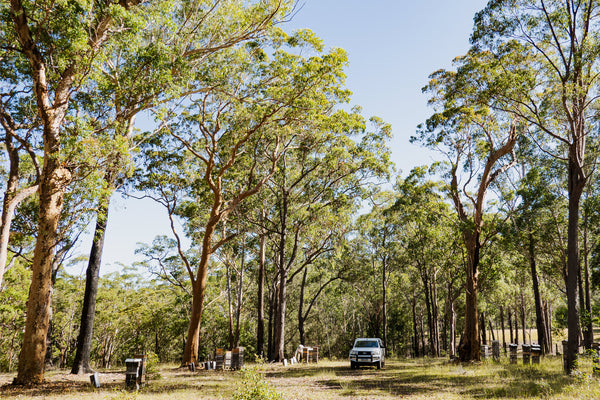 |
 |
| Warré apiary in a small clearing in the vast Wollemi Wilderness (400,000 Hectares), which is part of the Greater Blue Mountains | Fresh, pure nectar in 100% natural comb, entirely built by the bees |
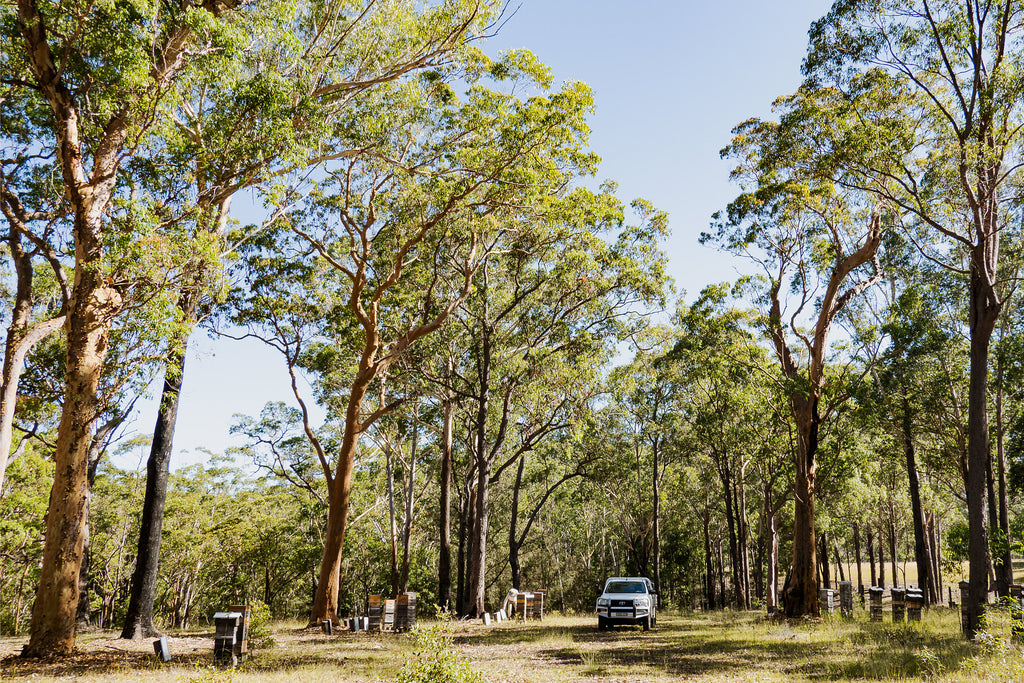 |
| Warré apiary in a small clearing in the vast Wollemi Wilderness (400,000 Hectares), which is part of the Greater Blue Mountains |
 |
| Fresh, pure nectar in 100% natural comb, entirely built by the bees |
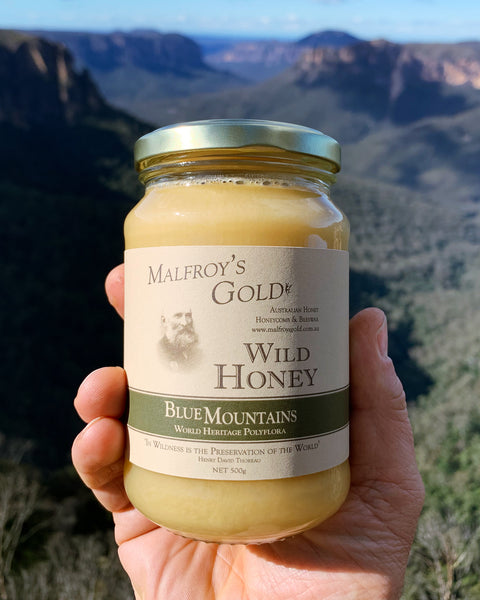 |
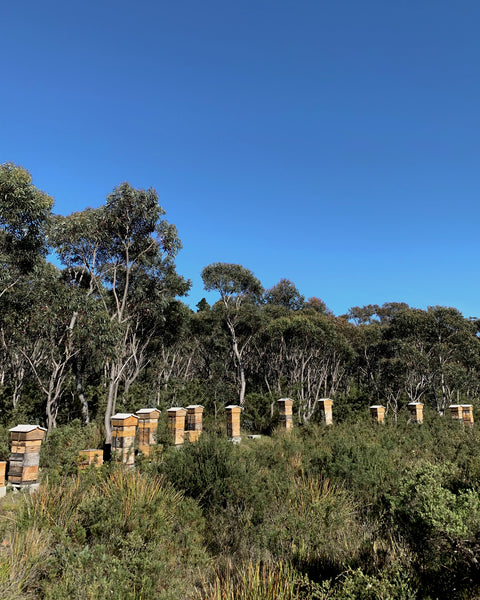 |
| Our Blue Mountains Wild Honey in its natural habitat! | A beautiful Warré apiary in the upper Blue Mountains, 1000m altitude |
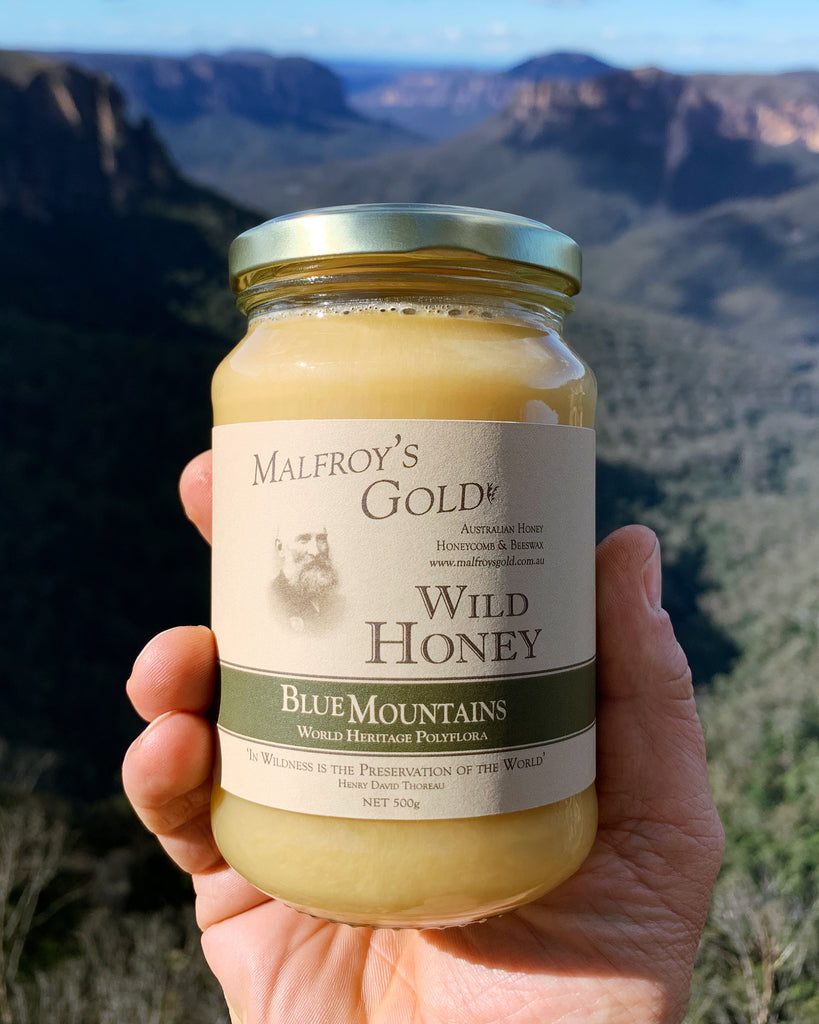 |
| Our Blue Mountains Wild Honey in its natural habitat! |
 |
| A beautiful Warré apiary in the upper Blue Mountains, 1000m altitude |
How Do We Achieve This?
1. Location, location, location We have made a conscious decision to establish apiaries in isolated locations, far away from the contaminating influences of urban areas and industrial agriculture (particularly broad acre cropping). As foraging bees cover a vast area (travelling up to 13km from the nest in search of food, but typically within a 3-5km radius) it is a challenge to find pristine locations.
Thankfully, most of our apiaries are located in the Blue Mountains wilderness - a two million hectare World Heritage Area resplendent with ancient forest, woodland and heath. Likewise, the adjoining Central Tablelands feature vast grassy woodlands, where we produce our Yellow Box, Red Stringybark and Mountain Meadow varieties in isolated areas.
2. Permanent apiaries
The vast majority of honey commercially available is produced by migratory apiarists - beekeepers who moves their hives constantly to new foraging areas to stimulate their bees and increase honey yield. This practise invariably increases the bees’ exposure to potential contaminating sites.
For the consumer seeking out chemical free honey, this poses a unique challenge, as much of the honey produced in pristine locations may be harvested from colonies that have spent some part of the season in other less pristine sites - potentially foraging on fields of GM canola!
Our apiaries are permanently located in isolated locations and never moved (unless in the case of a bushfire or other natural disaster), so we can always guarantee where the honey is coming from.
3. We only sell honey from our own hives
Much of the honey commercially available is packed and sold by food processing companies, not by beekeepers. Therefore any guarantee of provenance is hard to prove, and there is little to no control or monitoring of the movement of colonies or beekeeping practises involved. In contrast, we control the process from flower to jar.
4. No chemicals used in our beekeeping or entire operation
Our entire beekeeping operation is chemical free - we do not treat the hive with chemicals for pests and diseases, and we do not feed sugar or artificial pollen to the colonies. We also allow the bees to build all their own comb, guaranteeing purity. Commercially available beeswax, which is used for ‘foundation’ - the midrib of combs employed and re-used for many years in conventional beehives, has been found to be contaminated with chemicals.
5. Natural beekeeping principles
The five guiding principles of Natural beekeeping: natural comb, natural food, natural reproduction, zero chemicals and minimal intervention, allow bees to thrive on their own terms while supplying humans with a medicinal, pure food when genuine surplus is available.
* The Results
Other recent testing has revealed that our honey is unheated, medicinally active, free from sugar contamination - and now we can state it is also free from chemical contamination. Though these results may not be achievable for beekeepers in other areas (mainly due to factors relating to location), with careful thought about where colonies are placed and how they are managed we believe it is possible to increase the health of bees and purity of honey with natural beekeeping principles. We are proud to offer this unique product and thank you for your support.
| Chemical Residue Test ^ |
Analytes Detected |
| Glyphosate LCMSMS Analysis | None |
| Multiresidue Analysis 1 - Honey 1 Samples | None |
| Multiresidue Analysis 2 - Honey 1 Samples | None |
1 https://www.theguardian.com/environment/2022/oct/18/pesticide-use-around-world-almost-doubles-since-1990-report-finds
2 https://www.nature.com/articles/d41586-021-01143-3
3 https://www.hilarispublisher.com/open-access/survey-of-glyphosate-residues-in-honey-corn-and-soy-products-2161-0525.1000249.pdf
4 https://www.theguardian.com/environment/2023/jan/11/coalition-scrapped-pesticide-monitoring-program-that-found-residues-90-times-the-limit-on-strawberries
5 https://www.theguardian.com/environment/2017/oct/05/honey-tests-reveal-global-contamination-by-bee-harming-pesticides
6 https://www.ncbi.nlm.nih.gov/pmc/articles/PMC2841636/
7 https://www.stuff.co.nz/business/124578526/japan-rejects-nz-honey-with-traces-of-weedkiller-glyphosate
